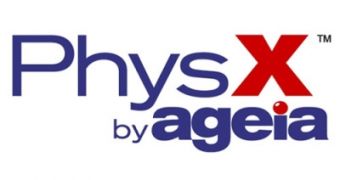Graphics expert Nvidia has just announced that it struck a deal with physics processing company Ageia, in order to integrate the physics processing engine in Nvidia's future generations of graphics cards. Two weeks ago, I have informed you that a deal was in progress, although both Nvidia and Ageia dismissed the information.
Ageia has been trying for some time now to set foot on the gaming market, but the company's PhysX processor unit (PPU) was constantly overlooked by game developers, since its implementation required additional attention. Until now, the company has had few successes, although its presence in the PlayStation3 environment was a real achievement. Moreover, Unreal Tournament 3 comes with full support for Ageia's PhysX engine, but the PhysX cards can only be found in ultra-high-end gaming systems.
"The computer industry is moving towards a heterogeneous computing model, combining a flexible CPU and a massively parallel processor like the GPU to perform computationally intensive applications like real-time computer graphics," Jen-Hsun Huang, president and CEO of Nvidia, in a statement. ''Applications such as physics, computer vision, and video/image processing are enabled through and heterogeneous computing."
Ageia being purchased by Nvidia will dramatically change its destiny. If the graphics expert manages to integrate Ageia's technology into its next generation of graphics cards, the physics engine will suddenly gain all the popularity and support the company has been craving for since 2002. Nvidia could also finance game developers to provide full support for the hardware engine as part of the "the way it's meant to be played" deal. At the same time, the graphics market would considerably change, since Nvidia will not have to struggle for improved GPU-based physics or discrete physics processing.
Nvidia has planned this move for years, and in the meantime, it acquired everything it considered that would help it in the fierce competition: first, there was the German company Mental, that would open Nvidia the gates of Hollywood, then there was Ageia, that will substitute for Nvidia's old lover (stolen by Intel in the meantime), Havok. And since Havok is part of Intel's life, Ageia is the 'next-best' investment.
On the other side, AMD is completely separated from the physics world. It lacks Havok, as well as it lacks Ageia, one of AMD's former targets that I have told you about previously. Nvidia and AMD are already bullying each other on the graphics stage, but Nvidia might soon attack it on different fronts, that are not (and cannot) be covered by AMD. If Nvidia manages to integrate the PhysX engine into its future GPUs, AMD had rather come with a better solution if it wants to stay competitive.

 14 DAY TRIAL //
14 DAY TRIAL //